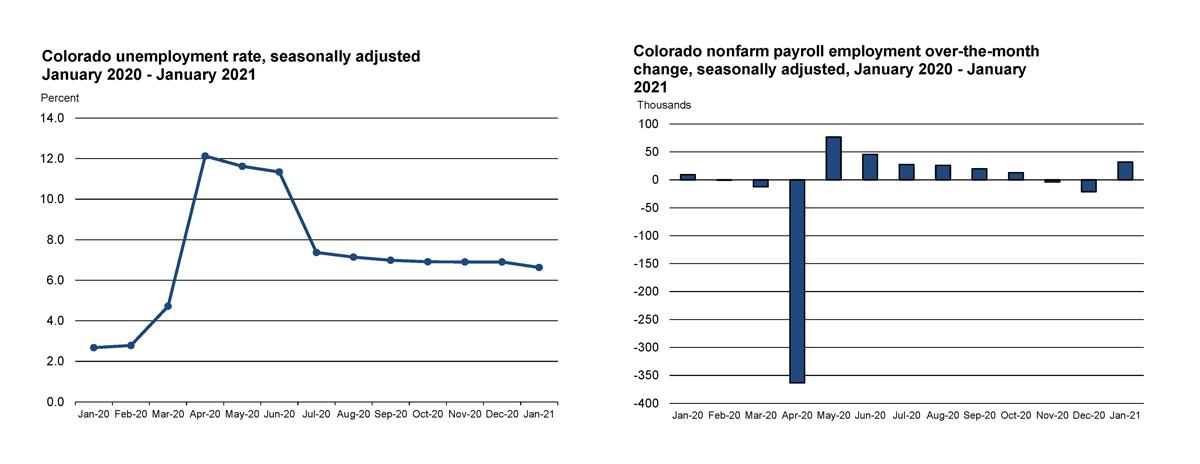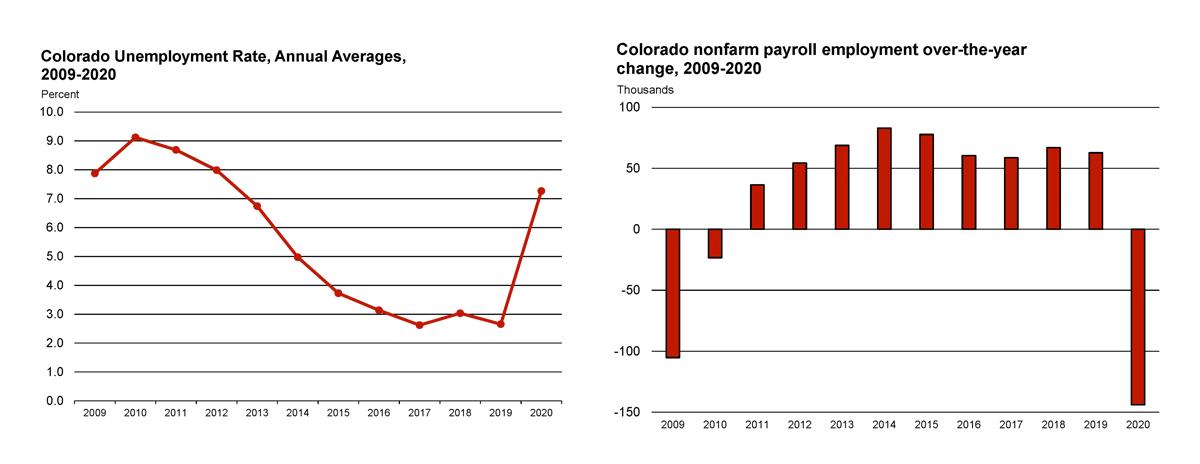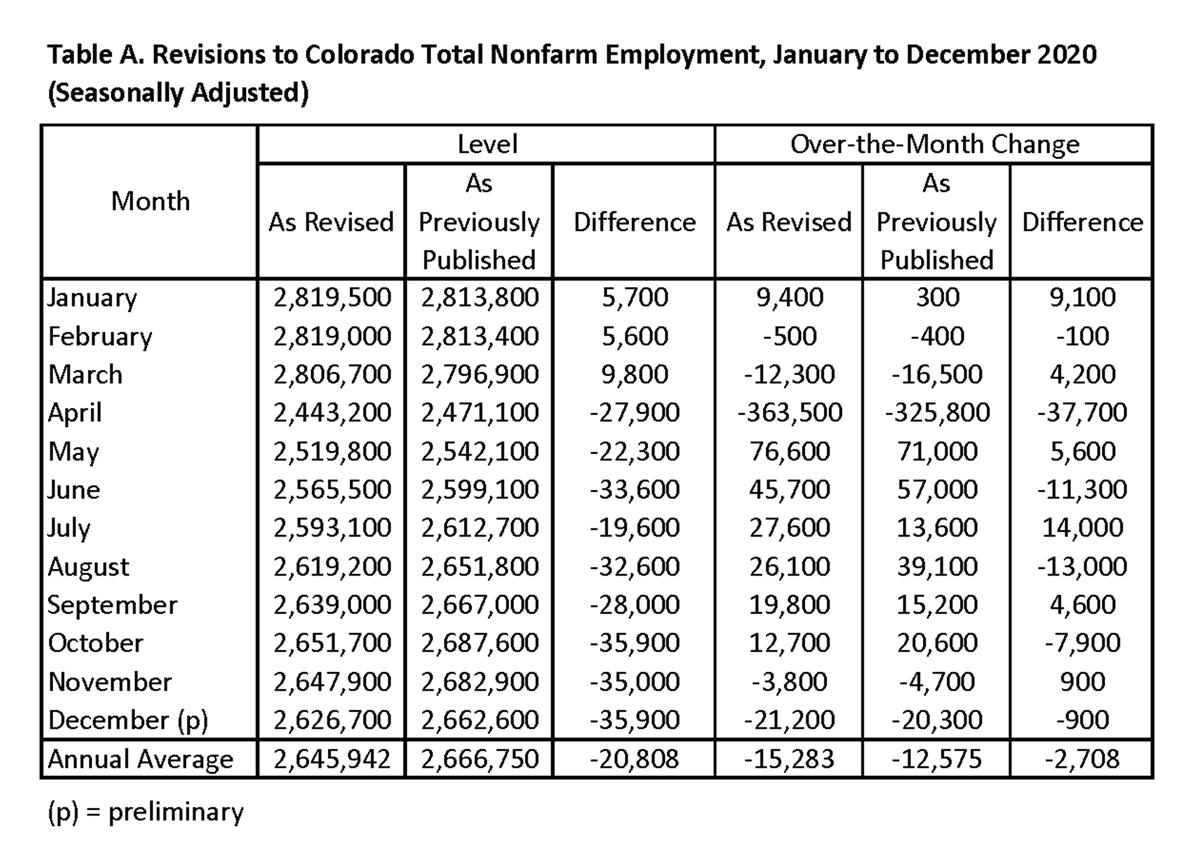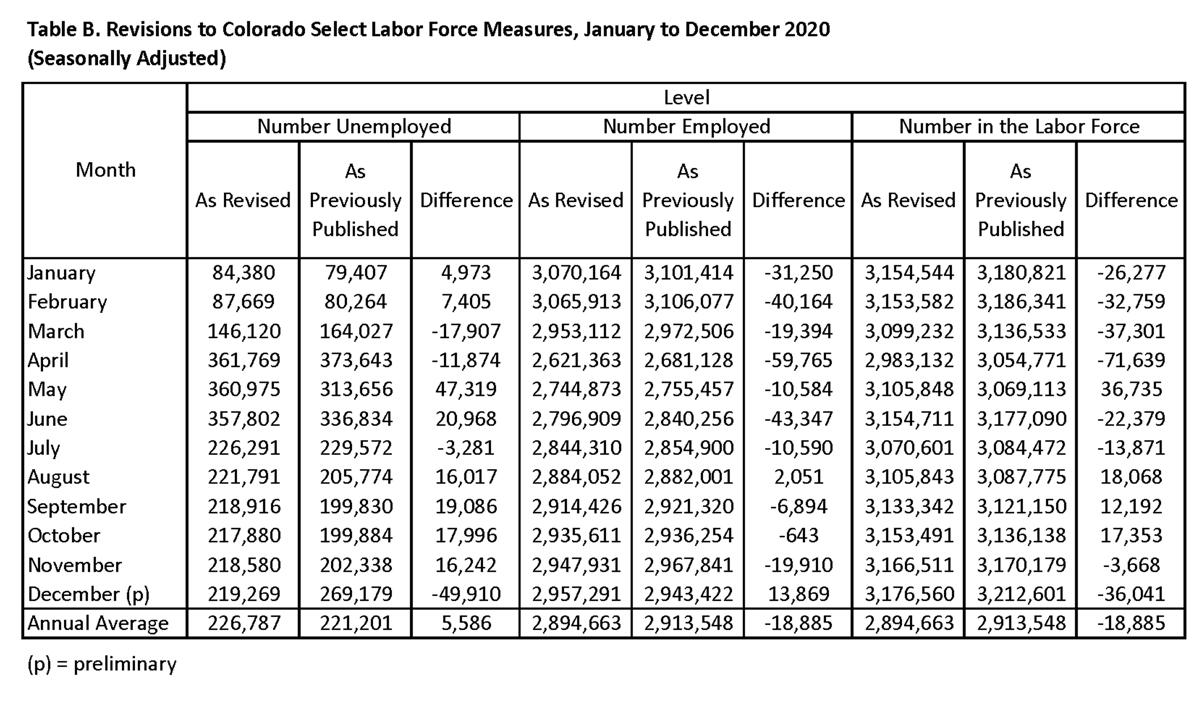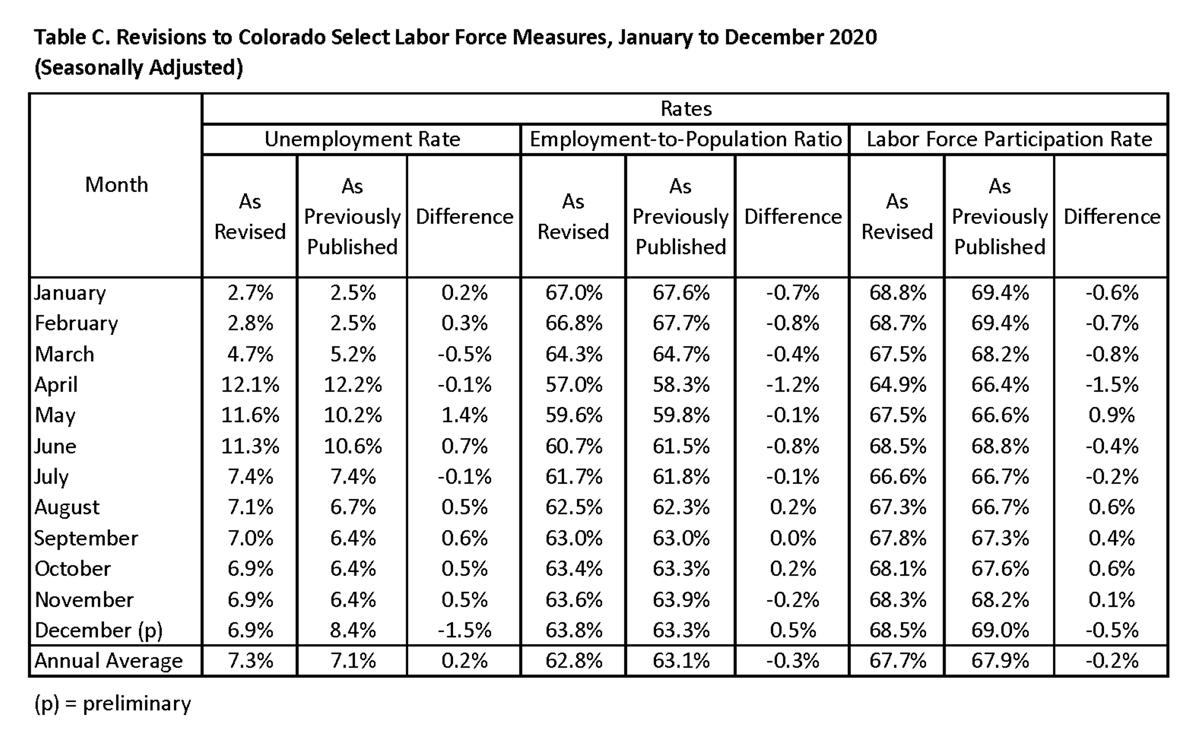For Immediate Release
Date: March 15, 2021 / 8:00 A.M.
Contact: Office of Government, Policy and Public Relations
Email: cdle_pr@state.co.us
Web: http://www.colmigateway.com
Colorado Employment Situation – January 2021
32,000 Nonfarm Payroll Jobs Added in January;
Unemployment Rate Falls to 6.6%
Household survey data
According to the survey of households, Colorado’s seasonally adjusted unemployment rate decreased in January to 6.6 percent from the revised December rate of 6.9 percent. The national unemployment rate dropped by four-tenths of a percentage point from December to 6.3 percent.
Other highlights from the household survey:
- Colorado’s labor force grew by 6,700 in January to 3,183,200. The labor force participation rate increased by one-tenth of a percentage point to 68.6 percent.
- The number of individuals employed in Colorado increased by 15,000 in January to 2,972,300, which represents 64.0 percent of the state’s 16+ population.
- The Colorado counties with the highest unemployment rates in January were: Huerfano (9.8%), Pueblo (9.3%), Gilpin (8.1%), Fremont (8.1%), Las Animas (7.9%), and Mesa (7.9%). County-level unemployment rates are not seasonally adjusted and are directly comparable to Colorado’s January unadjusted rate of 6.9 percent.
Establishment survey data
Nonfarm payroll jobs in Colorado rose by 32,000 from December to January for a total of 2,658,700 jobs, according to the survey of business establishments. Private sector payroll jobs increased by 28,400, while government added 3,600 jobs. Colorado has gained back 215,500 of the 375,800 nonfarm payroll jobs lost between February and April. That translates to a job recovery rate of 57.3 percent, which exceeds the U.S. rate of 55.8 percent.
Other highlights from the establishment survey:
- Private industry sectors with significant job gains in January were: leisure and hospitality (~21,200), professional and business services (~4,200), financial activities (~1,800), and trade, transportation, and utilities (~1,200). There were no significant over the month private sector job losses.
- Since January 2020, nonfarm payroll jobs have decreased 160,800, with losses totaling 135,900 in the private sector and 24,900 in government. The largest private sector job losses were in leisure and hospitality (~81,100), education and health services (~16,300), and other services (~8,400), and Colorado’s rate of job loss over the past year is -5.7 percent, compared to the U.S. rate of -6.3 percent.
- Over the year, the average workweek for all Colorado employees on private nonfarm payrolls increased from 33.0 to 33.6 hours, while average hourly earnings rose from $30.73 to $31.05, over a dollar and ten cents more than the national average hourly earnings of $29.94.
Annual averages and benchmark revisions to 2020 data
The annual unemployment rate for Colorado was 7.3 percent in 2020, revised up from the previously published 7.1 percent. Colorado’s peak unemployment rate, as recently revised, was 12.1 percent in April 2020. The U.S. unemployment rate in 2020 was 8.1 percent, with a peak rate of 14.8 percent in April.
Colorado nonfarm payroll employment declined at an annual rate of -5.2 percent in 2020, or 143,900 jobs. The U.S. annual payroll jobs growth rate in 2020 was -5.8 percent.
In accordance with annual practice, both establishment and household survey data estimates for Colorado undergo a benchmarking process. The benchmark process results in revisions to estimates for prior years. Below are select revisions to 2020 establishment and household survey estimates. More information on the benchmarking process is available at https://www.bls.gov/opub/hom/topic/benchmarking.htm.
###
All Colorado estimates from the establishment and household surveys, including greater geographic detail, are available at: http://www.colmigateway.com. Estimates for all states and the nation are available at: http://www.bls.gov.
The February 2021 Colorado Employment Situation will be released at 8:00 AM on Friday, March 26, 2021. The full schedule of release dates for calendar year 2021 estimates is available at http://www.colmigateway.com.
###
Technical Notes
It is a routine practice at the beginning of each year for the Bureau of Labor Statistics to revise estimates for prior years based on new information available and updated methodologies. Revisions to the unemployment rate and all related household survey based series as a result of the benchmark process this year were made back to 1976. Additionally, county estimates back to 2010 are subject to further revisions through April 16, 2021. For information on changes to model-based estimation for the household survey, please visit https://www.bls.gov/lau/launews1.htm. The nonfarm payroll jobs series for 1990 through 2020 were also revised in the benchmarking process. Additional information on benchmarking total nonfarm jobs estimates can be found at https://www.bls.gov/web/empsit/cesbmart.htm.
This release provides information on industry employment and labor force statistics for January 2021, the most current estimates available from the Colorado Department of Labor and Employment. The reference period for the establishment and household surveys was the pay period or week that includes the 12th of the month. Therefore, this release provides an estimate of Colorado’s employment situation during a decline in the number of COVID-19 cases across the state, which resulted in loosening restrictions for many establishments. For Colorado unemployment insurance claims activity and related statistics, visit www.colmigateway.com. For information regarding impacts to Bureau of Labor Statistics data collection and processing during the pandemic, go to www.bls.gov/bls/bls-covid-19-questions-and-answers.htm.
The unemployment rate, labor force, labor force participation, total employment and the number of unemployed are based on a survey of households. The total employment estimate derived from this survey is intended to measure the number of people employed.
Nonfarm payroll jobs estimates are based on a survey of business establishments and government agencies, and are intended to measure the number of jobs, not the number of people employed. Other series based on this survey include private sector average weekly hours, average hourly earnings and average weekly earnings.
The business establishment survey covers about seven times the number of households surveyed and is therefore considered a more reliable indicator of economic conditions. Because the estimates are based on two separate surveys, one measuring jobs by worksite and the other measuring persons employed and unemployed by household, estimates based on these surveys may provide seemingly conflicting results.
###
Supplemental Information | Labor Force Summary January 2021 | City Report January 2021 | County Report January 2021 | January 2021 Press Release
